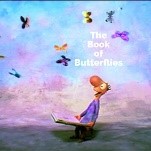Created on: 22 Dec 2020 | Last modified: 21 Apr 2023
HWB Focus: Relationships, Sexual Health and Parenthood.
Week 1
During spring/summer, introduce the lifecycle of the butterfly – this video clip maybe useful - Life Cycle of a Butterfly | #aumsum #kids #science #education #children - YouTube
Some additional websites to help discussion are - The butterfly life cycle! | National Geographic Kids (natgeokids.com)
If the child has a smaller brother or sister, they might want to read the story of the ‘Very Hungry Caterpillar’ to them or watch this short animated film together - https://www.youtube.com/watch?v=75NQK-Sm1YY
Your school may want to consider buying a butterfly growing kit to allow the children to watch first hand the lifecycle of the butterfly - Butterfly Growing at Home – Indoor Nature Fun for Kids (kidsofthewild.co.uk)
Encourage the children to try to attract butterflies into the school garden or their graden at home with this short experiment using a saucer of sugar water. Encourage the children to stay a short distance away (close enough so that they can see but not so close that they will scare them away). How many butterflies visit? Can they make a tally chart to count the number that visit and to record butterflies of different colours? (To compare what attracts the butterflies more, they might want to put out a saucer of plain water and compare how many visitors come to each saucer.) This guide might help them to spot some of the different types of butterflies - https://www.woodlandtrust.org.uk/trees-woods-and-wildlife/animals/butterflies/. How many red butterflies can they find?
Introduce symmetry – explain that each side of a butterfly’s wings are exactly the same – explore symmetry in nature and in the things around us. They might want to try some practical experiments using mirrors or paper shapes. Some ideas for symmetry experiments can be found here - https://earlyimpactlearning.com/symmetry-activities-for-kids/

Invite the children to watch this short clip from the Literacy Shed which shows butterflies lighting up the environment - https://www.literacyshed.com/butterflies.html
Using the clip, invite the children to think about the butterflies floating out of the book – can they think of some ‘wow’ words to describe them? Can they paint the butterflies with these ‘wow’ words next to them?
Invite the children to make their own butterflies – using whatever resources they have and prefer. This might be a 3D model, a chalk drawing or even a mobile. Hang them in the classroom windows or in their windows at home to cheer up those people in their neighbourhood who are out for a walk. Some examples from the Woodland Trust can be found here - https://www.youtube.com/watch?v=UDNFQ7z4Wcs
Week 2
Recap on what the children have learned about butterflies from last week – can they recall some key facts? This symmetry song might be helpful - https://www.youtube.com/watch?v=SJlhywRfvh8
Explore symmetry in nature – set the children a challenge to find things which are (like butterflies) symmetrical in nature. To give them a start, you might want to suggest that they look at some fruit and vegetables in the house. Here is a link to help - https://kidminds.org/symmetry-in-nature-for-kids-fun-with-fruits-and-vegetables/
Using the fruit and vegetables from the experiment, the children may want to explore the features of each half further through painting and print. Can they create a work of art?
Taking symmetry outside – ask the children to find things which are symmetrical outside. They might want to do this as part of a family activity when out for a walk. For some examples of symmetry in nature - https://www.youtube.com/watch?v=J-ykLPy9Un8 - don’t forget that rainbows can be symmetrical too!
Using the learning from symmetry in nature – building on the knowledge about plants which have symmetry, honeycombs and butterflies, invite the children to think about how they could encourage more bees and butterflies into the school garden or their garden at home. Develop this into ideas about planting flowers and/or vegetables. Sunflowers might be ideal to plant as the children can measure how tall they grow over time. (https://www.rhs.org.uk/education-learning/gardening-children-schools/family-activities/grow-it/grow/sunflower)
Why not invite the children to draw a sunflower or a flower of their own choice? A step by step guide can be accessed here - https://www.youtube.com/watch?v=yIOmduNQvtE. Some images might also give them some ideas - https://www.bing.com/images/search?q=Sunflower+Painting+by+Kids&FORM=RESTAB
If there is time, the children could look at Van Gogh’s ‘Sunflowers’ also (https://www.bing.com/images/search?q=Van%20Gogh%20sunflowers&qs=n&form=QBIR&sp=-1&pq=van%20gogh%20sunflower&sc=8-18&sk=&cvid=B784056E039043C49C4E4495C2CE5EA10 ) To access a step by step guide to re-creating the ‘Sunflowers’, this drawing tutorial might be helpful in the initial drawing of the picture - https://www.youtube.com/watch?v=lZ__t656tnI and the following link - https://www.youtube.com/watch?v=eYQDHgApivA – in looking at colour and texture.
Take this creativity into the kitchen and learn how to cook pizza. For a fun recipe, join Jamie Oliver, Petal and Buddy to make the family dinner - https://www.youtube.com/watch?v=K2RB1KcNtAM The children might even make their pizza symmetrical!
Note in relation to the use of online resources
Where online resources have been referenced, access to the resource is currently free. In some cases, this may be for a limited period and members should monitor their engagement on this basis. All online references have been selected on an illustrative basis for the relevant potential learning activities. There may be other websites and platforms which will provide similar activities. In referencing these websites, the EIS does not endorse any advertisements shown on the page, the views of those presenting or the wider content of the website.